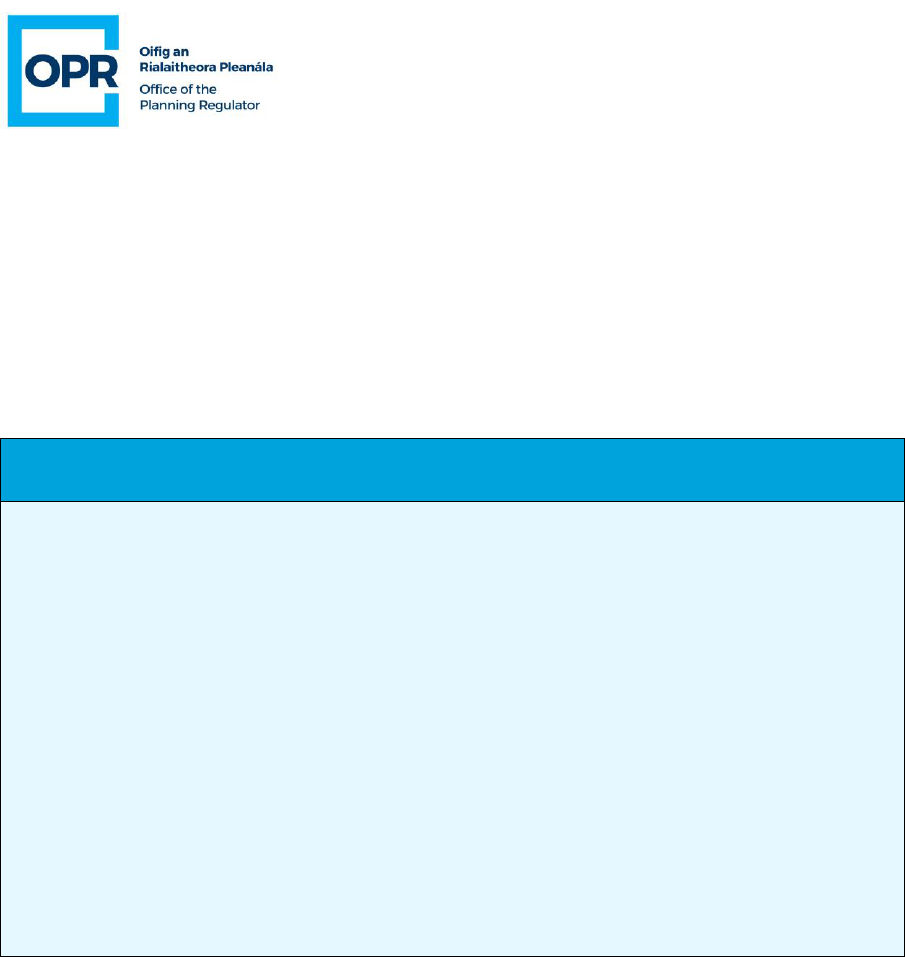
1 | Page
16 March 2021
Forward Planning Department,
Mayo County Council,
Áras an Chontae,
The Mall,
Castlebar,
Co. Mayo,
F23 WF90.
Re: Draft Mayo County Development Plan 2021 – 2027
A Chara,
Thank you for your authority’s work in preparing the draft Mayo County Development Plan
2021- 2027 (the draft Plan).
The Office of the Planning Regulator (the Office) wishes to acknowledge the considerable
work your authority has undertaken in the preparation of the draft Plan against the backdrop
of an evolving national and regional planning policy and regulatory context. In particular, the
Office commends the preparation of a Housing Need Demand Assessment (HNDA) to inform
the Core Strategy and Housing Strategy in Volume 4.
More recently, you will have been notified of the Ministerial Circular relating to Structural
Housing Demand in Ireland and Housing Supply Targets, and the associated Section 28
Guidelines: Housing Supply Target Methodology for Development Planning. The planning
authority will, therefore, be required to review the draft Plan, and in particular the Core
Strategy, in the context of this guidance which issued subsequent to the draft Plan. Further
advice in relation to this matter is provided below.
As your authority is aware, a key function of the Office is the assessment of statutory plans
to ensure consistency with legislative and policy requirements relating to planning.
The Office has evaluated and assessed the draft Plan under the provisions of sections
31AM(1) and (2) of the Planning and Development Act 2000, as amended (the Act) and this
submission has been prepared accordingly.

2 | Page
Recommendations issued by the Office relate to clear breaches of the relevant legislative
provisions, of the national or regional policy framework and/or of the policy of Government,
as set out in the Ministerial guidelines under section 28. The planning authority is required to
implement or address recommendation(s) made by the Office.
Observations take the form of a request for further information, justification on a particular
matter, or clarification regarding particular provisions of a plan on issues that are required to
ensure alignment with policy and legislative provisions. The planning authority is requested
by the Office to action an observation.
A submission also can include advice on matters that the Office considers would contribute
positively to the proper planning and sustainable development of the area. The planning
authority is requested by the Office to give full consideration to the advice contained in a
submission.
Overview
The draft Plan is being prepared at a crucial time following the preparation of the National
Planning Framework (NPF) and the Northern and Western Regional Assembly Regional
Spatial and Economic Strategy (RSES) which seek to promote the rebalancing of regional
development in a sustainable manner. The draft Plan has proactively embraced many of the
challenges and opportunities identified in the NPF and the RSES through the identification of
town centre consolidation sites in Tier 2 and Tier 3 settlements and the promotion of
economic initiatives including Ireland West Airport Knock SDZ (EDP2) and the Castlebar-
Westport Economic Growth (CWEG) Cluster 2040. Other measures including those
addressing climate change, which are promoted throughout the draft Plan, are also
welcomed.
The new planning policy context for planning authorities and regional assemblies set by
Government in the NPF is centred on supporting and strengthening the rural economy
through the sustainable regeneration of rural towns and villages and by promoting
consolidation and compact and sequential development in all urban and rural settlements.

3 | Page
The challenge as clearly outlined in the draft Plan is to build on the unique dispersed
settlement characteristics of Mayo, in order to provide a balance, link and synergy between
the rural countryside and urban settlements, ensuring a high quality of life for residents in a
sustainable manner.
In this context the office considers that the towns of Castlebar, Ballina and Westport,
together with some of smaller towns of Charlestown, Kiltimagh, Foxford and Crossmolina,
provide an excellent opportunity to support development and growth to a greater degree than
currently proposed, This will also be important in terms of supporting the policies in the draft
Plan targeting population stagnation, rejuvenation and regeneration of settlements, including
high vacancy rates in Ballina and Castlebar.
Outside of the main settlements, the Office acknowledges and welcomes the strong policy
commitments for the regeneration and renewal of rural towns and villages consistent with
NPO18 but considers that a greater focus is needed on Tier IV and V villages as a more
sustainable alternative to urban generated housing in the open countryside and to support
the economic basis of those rural towns and villages.
The rebalancing of future growth in accordance with the Recommendations made below will
be important to ensure that the Mayo is less car-dependent and energy intensive, easier to
service with public transport, social and physical infrastructure, and to provide greater
support to rural communities through their towns and villages consistent with national and
regional policy.
The planning authority will also be aware that the Office’s evaluation of the plan is required
under section 31AM(2)(a) to address, in particular, matters within the scope of section
10(2)(n) of the Act in relation to climate change. The definition of appropriate settlement
boundaries, the zoning of lands for specific uses (section 10(2)(a) of the Act), and the
establishment of guiding policies for smaller towns and settlements are vital tools available to
the planning authority in promoting effective integration of land use and transportation
policies and addressing the requirements of section 10(2)(n).
It is within this context the submission below sets out 17 recommendations and 10
observations under the following eight themes:

4 | Page
Key theme
Recommendation
Observation
Core strategy and settlement strategy
Recommendation 1, 2, 3,
4, 5, 6, 7
Observation 1, 2
Compact growth, regeneration and
approach to land use zoning
Recommendation 8, 9
Observation 3, 4
Rural housing and regeneration
Recommendation 10, 11
Economic development and
employment (including retail)
Recommendation 12, 13
Observation 5
Sustainable transport and accessibility
Recommendation 14
Observation 6
Climate action and renewable energy
Recommendation 15, 16
Observation 7
Environment, heritage and amenities
Recommendation 17
Observation 8, 9, 10
General and procedural matters
1.0 Core Strategy and Settlement Strategy
1.1 Core Strategy
Notwithstanding that the plan review process has commenced for County Mayo, the
Guidelines specify that it will be necessary to demonstrate the manner in which the Core
Strategy and other elements of the plan are consistent with the NPF 50:50 City housing
demand projection scenario identified by the ERSI (Appendix 1 Table 25) subject to the
methodology set out in Section 4.0 of the Guidelines and adjusted for your plan period.
This will require a review of the draft Plan in order to plan to provide housing to the extent
identified in the Guidelines and the accompanying Circular in the core strategy, settlement
strategy and associated identification of the potential quantity of land required to meet the
housing supply targets in each settlement.
This exercise may require a reduction in the level of growth from that set out in the draft Plan
in order to ensure consistency with the NPF 50:50 scenario.
Recommendation 1 – Review of the proposed Core Strategy
In accordance with Sections 10(2B) and 10(2A)(c) & (d) of the Planning and Development
Act 2000, (as amended) and having regard to the Guidance Note on Core Strategies

5 | Page
2010, and the Section 28 Guidelines: Housing Supply Target Methodology for
Development Planning 2020, the planning authority is required to:
a. Review the proposed Core Strategy (including settlement strategy and associated
identification of development potential and zoning exercises) and HNDA and to
revise as necessary to comply with the requirements of the Section 28 Guidelines:
Housing Supply Target Methodology for Development Planning 2020 and Appendix
1 of the accompanying Ministerial Circular.
b. Amend Core Strategy Table 2.4 to provide the quantity in hectares of existing and
proposed residential zoned land and land zoned for a mix of residential and other
uses which are permitted to accommodate residential use in the draft Plan for each
settlement. The planning authority is advised that the total figures for the county
should align with the housing supply targets generated in response to
Recommendation 1a above.
Observation 1 – Core Strategy Table (Table 2.4)
The planning authority is requested to amend and supplement the information in the Core
Strategy Table (Table 2.4) to include 2016 Census of Population figures for Tier V (Rural
Villages) with interpolated forecast of population figures for the years 2021, 2027 and
2031, with specific reference to the Tier I – III settlements.
1.2 Settlement Strategy
Hierarchical Structure
The RSES identifies two towns in County Mayo as Key Towns in the county settlement
hierarchy, namely Ballina and Castlebar. Specific to County Mayo, the RSES also identifies
locations with strategic development potential of a regional scale, including Westport and the
SDZ Ireland West Airport Knock.
The draft Plan labels the Tier I towns of Ballina and Castlebar as ‘Strategic Growth Centres’
and not as ‘Key Towns’ as designated in the RSES. In order to ensure consistency and
facilitate transparency within the settlement hierarchy in conformance with the RSES, it is

6 | Page
considered that Ballina and Castlebar should be correctly labelled and referenced as Tier I
Key Towns throughout the plan.
The Office notes that the draft Plan proposes a significant change to the current
development plan (settlement hierarchy) with the elevation of Westport from a Tier 2 to a Tier
1 settlement, notwithstanding that Westport is not designated as a Key Town in the RSES
with a 30% growth target (Table 4, Regional Policy Objective (RPO) 3.1).
Accordingly, the position of Westport within the settlement hierarchy should be reconsidered
whereby its strategic development potential can be realised and its intrinsic links with
Castlebar strengthened, while acknowledging the higher functional role of Ballina and
Castlebar as Key Towns in the RSES.
Recommendation 2 – Settlement Strategy
Having regard to Table 4.0 (Key Towns) and Section 3.8 of the Regional Spatial and
Economic Strategy (RSES), the settlement strategy objectives set out under Regional
Policy Objective 3.1 and National Policy Objective 9, the planning authority is required to:
a. change the designation/reference of the Tier 1 towns of Ballina and Castlebar from
Strategic Growth Centres to Key Towns; and
b. amend wording in the draft Plan that makes reference to Westport as a Key Town
and reconsider its position within the county settlement hierarchy consistent with
Westport’s identified role in the RSES as a location with strategic development
potential of a regional scale with intrinsic links with Castlebar, thereby enabling the
Plan to deliver a Core Strategy in accordance with the legislative requirements, the
national and regional policy requirements and the requirements of Section 28
guidelines.
Distribution of Population Growth
From an evaluation undertaken by the Office, it is evident that the distribution of future
population growth across the settlement hierarchy does not provide a strategy that
sufficiently responds to the policies and objectives of the NPF and RSES regarding
settlements identified for significant rates of population growth, compact growth and reversal
of rural decline in villages, as set out in NPOs 3c, 9, 16, 18a; and RPO 3.1.

7 | Page
In particular, the Office makes the following specific comments in respect of the rates of
population increase that are provided for across the settlement hierarchy:
The Core Strategy allocates the same population growth (19.4%) for Westport as for the Key
Towns of Ballina and Castlebar over the plan period, notwithstanding that Westport is not
designated as a Key Town intended to accommodate significant growth in the RSES
consistent with NPO 9. (See Recommendation 2).
The population growth for Ballina and Castlebar (19.3%) is considered low in contrast to the
Tier II towns (17.7%). It is considered that Tier 1 settlements, designated as Key Towns with
significant potential for compact growth, require a slightly higher growth rate if they are to
grow in line with the objectives set out in Section 3.4 and RPOs 3.1 and 7.16 of the RSES.
The population allocation to the Tier III Self Sustaining Towns (9 no.) is low with a cumulative
future growth allocation of 5.1% (total population increase of 9.9%). In contrast, the future
growth allocation for the 5 no. Self-Sustaining Growth Towns is 11.9%. The Office considers
there are significant settlements within Tier III (Charlestown, Kiltimagh, Foxford and
Crossmolina) which may have capacity to absorb further growth particularly having regard to
the new wastewater treatment plant in Charlestown and the planned upgrade in Foxford.
The Core Strategy allocates a total of 46.6% of future population growth to rural Mayo
inclusive of Tier IV and Tier V settlements and the Open Countryside. Of the total future
population growth in the rural area, only 9.5% is allocated to Tier IV and Tier V rural
settlements and villages with the remaining 90.5% allocated to the open countryside. The
Office considers that this allocation is contrary to one of the Strategic Aims of the draft Plan
which seeks to develop Mayo's settlements as a network of attractive, liveable towns and
villages in the county with sustainable levels of population, employment activity and
enhanced levels of amenity
1
.
The Office notes that the forecasted increase of 7.9% in population growth in the Open
Countryside, representing 42.1% of all future population growth in the county over the plan
period
2
, has not been informed by an evidence-based approach, as required under NPO 20
and under the Sustainable Rural Housing Guidelines for Planning Authorities (2005).
1
Section 2.3 – Strategic Aims, page 26 of draft Plan

8 | Page
Notwithstanding the rural nature of the county and the objectives in the draft Plan to provide
a balance, link and synergy between the rural countryside and urban settlements, it is
considered that the growth rates as set out in the Core Strategy are unbalanced and could
undermine objectives for compact growth in Key Towns (RPO 3.1) and support for the role of
smaller and medium sized towns as defined in the RSES (RPO 3.13 and RPO 7.20).
Recommendation 3 – Distribution of Population Growth
Having regard to Recommendations 2 and 3 above and the National Policy Objectives
(NPO) for planning for the future growth of and development of rural areas contained in
the National Planning Framework, in particular NPOs 15, 16 and 20, the planning authority
is required to rebalance the overall allocation of population growth and housing supply
targets across the settlement hierarchy to achieve a more sustainable distribution of
growth focused on towns and villages across the county. In particular the planning
authority is required to:
a. alter the population growth rate for the Key Towns of Castlebar and Ballina, such
that the Key Towns have a higher proportion of the Core Strategy population/
housing growth and which recognises their role as key drivers supporting the
higher-order centres distinct from Westport and the Tier II settlements and
consistent with Section 3.4 and Regional Policy Objective (RPO) 3.1 and RPO 7.16
of the Regional Spatial and Economic Strategy;
b. increase the Core Strategy population/ housing allocation to the Self Sustaining
Towns with particular regard to the larger towns of Charlestown, Kiltimagh, Foxford
and Crossmolina which may have capacity to absorb further growth, particularly
having regard to new wastewater infrastructure in Charlestown and the planned
upgrade in Foxford;
c. reduce the Cores Strategy population growth allocation of 42% to the Open
Countryside to give effect to the above, and rebalance the remaining allocation to
the rural villages within Tiers IV and V rather than the open countryside in order to
target the reversal of decline in small towns and villages and to contribute to their
regeneration and renewal, demonstrating consistency with NPOs 16, 18a, 18b and
RPO 3.3. A clear evidence-based approach is required to determine the demand
for one off rural housing in the open countryside over the plan period as required

9 | Page
under NPO 20 and under the Sustainable Rural Housing Guidelines for Planning
Authorities (2005).
Residential Land Supply & Policy
The RSES requires distribution of balanced growth across the county subject to
safeguarding the growth of Key Towns. A robust evidence based analysis of demand, past
delivery and potential is therefore necessary to justify core strategies. The Office’s analysis
of land supply and housing policy in the draft Plan has identified three key issues: insufficient
information to support implementation and delivery of the core strategy for Tier I and Tier III
towns; a lack of justification for the quantity of land zoned for residential development; and
the lack of information regarding a tiered approach to zoning (TAZ).
Development Approach for Settlements
The Office welcomes the intention to prepare local area plans for the settlements of Ballina,
Castlebar and Westport (Objective CSO 3) in keeping with the requirements of the Act. It
also welcomes the recent publication of the pre-draft issues paper for the Castlebar Local
Area Plan 2021 – 2027. However, the Office considers that the absence of updated
settlement plans and associated zoning maps for Tier 1 towns means that there is
insufficient information in the draft Plan to effectively guide development and future
population growth in accordance with recent national and regional polices objectives.
In the interim and pending the adoption of an LAP for the Tier 1 towns, it is imperative that an
adequate planning framework is put in place to ensure that plan led development can be
facilitated in the short term and that these towns can be developed in a compact and
sustainable manner.
Not only is this information necessary to facilitate plan led development but importantly it is
also necessary to satisfy legislative requirements under Section 10(2) of the Planning &
Development Act 2000, (as amended).
Recommendation 4 – Development Approach for Settlements
The planning authority is required to review its approach and provide greater clarity and
transparency in the delivery of the Core Strategy objectives for the Key Towns of Ballina

10 | Page
and Castlebar and the town of Westport, and to clearly set out how the objectives in
Section 10(2) of the Planning & Development Act 2000 (as amended) are to be achieved
in the interim and pending the adoption of Local Area Plans for these settlements.
At a minimum the planning authority is required to prepare maps and stronger policy
objectives, identifying strategic objectives for each town consistent with sections 3.4, 3.8
and 3.9 of the Regional Spatial and Economic Strategy. In this regard, the settlement
plans should include a settlement boundary, compact growth area, core retail area, key
regeneration sites, strategic employment sites, constraints such as flooding, sustainable
mobility and relevant key future priorities.
Whilst the consolidated land use approach to zoning may be acceptable, subject to
modifications, in lower tier settlements, it is considered that traditional zoning maps are
required for the higher order Tier III settlements. Zoning maps facilitate transparency and
provide greater clarity in encouraging and enabling development. They are considered
necessary to ensure effective implementation and delivery of the policy framework and also to
avoid public confusion. This is particularly important in the context of compact growth and
regeneration (NPOs 3c, 6, 7; RPOs 3.1 and 7.16 refer).
The consolidated zoning approach in lower tier settlements, whilst acceptable in principle
would benefit from further clarification to enable delivery of compact growth and appropriate
regeneration. Clarification is also required on the zoning objectives of these ‘Consolidation
Zones’ with particular reference to deliver obligations under Part V social & affordable housing
3
in accordance with section 94(4)(c) of the Planning and Development Act 2000 (as amended).
Recommendation 5 – Development Approach to Settlements
The planning authority is required to revisit the development approach for the Tier III to Tier
V settlements and provide a strategic and structured approach to the implementation of the
plan’s policy framework, thereby ensuring consistency with National Planning Objectives 3c,
6 and 7 and Regional Policy Objectives 3.1 and 7.16. In this regard the planning authority
is required to:
a. Provide land use zoning maps for all Tier III settlements, consistent with
objectives set out in the written statement of the Settlement Plans, cognisant of
3
Objective HSO 2 of the draft Plan seeks to implement Part V on all land zoned solely for residential use, or for a mixture of
residential or other uses. It should be clarified here that Part V also applies to the Consolidation zoning.

11 | Page
their position within the settlement hierarchy and projected future population
growth.
b. Review the development boundaries and reduce the extent of consolidated
zoning in Tier IV and Tier V towns and villages to reflect the extent of the
established settlement and promote a sequential approach to development to
ensure compact growth and avoid ribbon development consistent with the
guidance in Sustainable Rural Housing Guidelines for Planning Authorities 2005.
c. Refine the consolidated approach to zoning to include specific local objectives
such as for the town / village core area, focal spaces, amenities, sustainable
mobility/movement and opportunity sites.
d. Identify land with development constraints such as flooding on the consolidated
zoning maps. Where land subject to flood risk is sequentially preferable and could
contribute to compact growth, it will be necessary to undertake a Justification Test
within the context of the Strategic Flood Risk Assessment (refer to
Recommendation 9).
Observation 2 – Self Sustaining and Rural Consolidation Zoning
The Planning Authority is requested to clarify the specific wording in relation to the Self
Sustaining and Rural Consolidation Zoning to ensure that Part V social & affordable
housing is delivered in accordance with section 94(4)(c) of the Planning and Development
Act 2000 (as amended).
Quantity of Zoned Land
Having regard to the extent of land zoned in the existing Mayo County Development Plan
2014 – 2020 and Town Development Plans, there appears to be a historic legacy of
excessive land use zoning, particularly in relation to residential zoned lands which is
inconsistent with the policy framework in the NPF and RSES. While the Office supports the
clear effort of your authority to address this issue, by identifying Strategic Residential
Reserve Lands and rezoning lands on the periphery of towns as 'Rural Transition', our
evaluation indicates that the quantity of land zoned for residential use, or a mixture of
residential and other uses, remains in excess of the population and housing growth targets
set out in the Core Strategy. For example, in Ballinrobe there are 34.1 hectares of
undeveloped land zoned ‘Residential’ to accommodate the expected 192 housing units over

12 | Page
the plan period. In addition to this, 29.0 hectares is also zoned as ‘Strategic Residential
Reserve’.
The quantity of land zoned for development purposes in the draft Plan will need to be
reviewed (and possibly reduced) in light of the revised Core Strategy arising from
consideration of the Section 28 Guidelines: Housing Supply Target Methodology for
Development Planning (Recommendation 1) and rebalancing of anticipated growth across
the settlement hierarchy (Recommendation 3). The revised zoning maps should ensure that
developed land is easily identifiable and that a clear distinction is made between residential
zoned land and land identified as strategic residential reserve.
Having regard to certain gaps in the information provided in the draft Plan, further information
will be required to provide greater clarity and transparency regarding the potential quantity of
land required to meet the housing supply targets in each settlement to demonstrate
consistency with Section 10(2A) of the Act and the provisions of the NPF and RSES for
compact growth and sequential development, including:
- the quantity of land zoned in each settlement including the projected residential yield
from land zoned for a mix of residential and other uses,
- the basis upon which the land requirement is calculated using densities consistent
with the Sustainable Residential Development in Urban Areas Guidelines (2009). The
Office notes that the plan promotes densities which are at variance with the
aforementioned such as 20 units per hectare or less in inner urban suburbs and 5
units per hectare or less in the urban periphery or rural settlements. While it is
reasonable for the draft Plan to provide a tailored approach to the consideration of
residential densities for settlements depending on their size and character/function, it
is nonetheless important that the draft Plan provides for higher residential densities
within the ranges advised in the Guidelines to support national and regional policy
objectives for compact growth.
The Office also notes that there is a significant quantity of land zoned as ‘Strategic
Residential Reserve’ in the draft Plan which “seeks to provide for the longer-term housing
requirements of the town” and which vastly exceeds the quantity of land zoned for new
residential development. For example, in Claremorris, 43.1 hectares of land is zoned for

13 | Page
‘Strategic Residential Reserve’, in addition to the 17.1 hectares of undeveloped land zoned
for ‘Residential’ in the settlement.
While it is acknowledged that this arises in most part from the legacy of over zoning, the
location of this land in some instances, is at remote locations on the fringes of towns and
villages, well removed from town / village cores and is contrary to national and regional
objectives to provide for compact growth (NPO3c; NSO1 and RSO2). In other instances,
including at locations in Ballyhaunis, Ballinrobe and Claremorris, land adjoining the town core
has been zoned as Strategic Residential Reserve with new residential zoning located further
from the centre. This is contrary to the development of zoned land in a sequential manner
and is inconsistent with the objectives of the NPF and the RSES for compact growth.
Given the nature, extent and location of the lands concerned, the wording supporting the
Strategic Residential Reserve objective in the draft Plan would benefit from additional clarity
to make it clear that such lands will not be considered for development under the lifetime of
the proposed development plan. The development of such lands to accommodate single
houses during the period of the proposed plan would not be consistent with national and
regional policy objectives concerning compact growth and would be inconsistent with the
Core Strategy proposed under the draft Plan. It would also undermine the logical future
development potential of these lands.
Recommendation 6 – Quality of Zoned Land
To provide the clarity and transparency necessary to ensure the effective delivery of
compact growth, in accordance with National Policy Objectives 3c and 72(a-c), the planning
authority is required to:
a. Reconsider and appropriately reduce the provision of all zoned residential land, and
land zoned for a mix of residential and other uses, to align with the quantity of land
necessary to accommodate housing supply targets in the (revised) Core Strategy.
b. Review the quantity of land zoned strategic residential reserve to reflect the longer
term Housing Supply Targets (refer to Recommendation 1). The revised zoning
maps should ensure that there is a clear distinction between developed and
undeveloped zoned land and between residential zoned land and that land identified
as strategic residential reserve.
c. Review density assumptions used to estimate the quantity of zoned land arising from
the Housing Supply Targets in the revised Core Strategy. These densities should

14 | Page
comply with the recommended residential densities for large towns, small towns and
villages in the Sustainable Residential Development in Urban Areas Guidelines for
Planning Authorities (2009).
d. Adopt a sequential approach to the zoning of lands, such that lands identified for
residential development in proximity to the town core are prioritised over land
removed from the town core.
e. Clarify the Strategic Residential Reserve Objective to ensure that no residential
development proposals, including single housing, will be considered by the planning
authority, on lands identified as Strategic Residential Reserve until after the full
lifetime period of the development plan 2021-2027.
Tiered Approach to Zoning
The draft Plan (section 12.3.1.1) suggests rather than states categorically that the tiered
approach to zoning (TAZ) has been applied, as required by the NPF (NPO 72a, NPO 72b
and NPO 72c refer) and Section 10(2A)(d)(ii) of the Act. In addition, no infrastructural
assessment report is attached to the draft Plan and it is not evident which lands are already
serviced or can connect to services, and what lands are to be provided with full services
within the life of the Plan to accommodate the population growth proposed under the Core
Strategy.
Recommendation 7 – Tiered Approach to Zoning
The planning authority is required to demonstrate that the tiered approach to zoning
required under the National Planning Framework (policies NPO72a, NPO72b and NPO72c
refer) has been applied, which should have regard to the provisions of an Infrastructural
Assessment Report, details of which must be included in the Development Plan, all in
accordance with the methodology set out in Appendix 3 of the NPF.
2.0 Compact Growth and Regeneration
2.1 Regeneration Delivery
The Office welcomes the strong policy commitments to the regeneration and renewal of
towns and villages in the County including identification of Town Centre Consolidation Sites
in Tier II and III settlements identified to encourage town centre consolidation and
revitalisation. The draft Plan appropriately supports a range of site activation measures and

15 | Page
is commended for including an indicative Framework Plan to demonstrate how each
identified consolidation / opportunity site in Tier II towns can be delivered.
However, without quantifiable data in the draft Plan, including the location and quantity of
infill, brownfield and town centre consolidation sites, it is not clear how 30% of future housing
requirements within the existing built up footprint of all settlements can be delivered in
accordance with NPO 3c. Measurable data is necessary to facilitate monitoring of the plan
and to establish if the 30% target has been achieved at the end of the plan period.
While the draft Plan does promote the implementation of a monitoring strategy for the
delivery of housing (CSO 8 & CSO 9 of draft Plan) and does seek to establish a database of
strategic brownfield and infill sites (BEO 36 of draft Plan), this approach could be further
strengthened by establishing measurable targets (perhaps by settlement at the upper levels)
and timelines against which the implementation can be monitored and measured.
The Office notes that only town centre lands have been identified for the specific purpose of
renewal and regeneration under the Urban Housing and Regeneration Act 2015 for the
purposes of application of the Vacant Site Levy (Objective BEO 35) and that town centre
zoning only applies to Tier II settlements. Objective BEO 35 should be expanded to ensure
that it can be applied to Tier 1 towns and all other towns and villages identified in the
settlement hierarchy, including the Tier III – V settlements covered by the Self Sustaining
and Rural Consolidation Zoning.
Recommendation 8 – Regeneration Delivery
While the identification of town centre consolidation sites in Tier II and Tier III settlements is
welcomed and promotes regeneration and compact growth in such towns, the planning
authority is required to:
a. Quantify and identify those areas of settlements which will contribute to the
cumulative delivery of 30% of all new homes within the built-up footprint of
existing settlements and demonstrate consistency with the housing and
population requirements set out in the amended Core Strategy and policy
promoting compact growth through application of the brownfield definition as set
out in the Sustainable Residential Development in Urban Area Guidelines for
Planning Authorities (2009).

16 | Page
b. Amend Objective BEO 35 to ensure that adequate lands (not just town centre
lands) are identified for the specific purpose of renewal and regeneration under
the Urban Housing and Regeneration Act 2015 for the purposes of application
of the Vacant Site Levy, including lands covered by the Self Sustaining and Rural
Consolidation Zoning, where necessary.
Observation 3 – Active Land Management
Having regard to RPO 3.1 and regional policy objectives for regeneration and revitalisation
in Chapter 3 of the RSES, the planning authority is requested to set out a clear timeline
and strategic approach to carrying out the Active Land Management proposals and to set
measurable targets (perhaps by settlement at the upper levels) and timelines against
which the implementation can be monitored and measured.
2.2 Flooding
A review of the Strategic Flood Risk Assessment (SFRA) indicates elevated levels of flood
risk in various locations across the County, with specific reference to towns and villages in
Tiers II – V. The Tier 1 towns of Ballina and Castlebar and the town of Westport have been
omitted from the SFRA and there is no indication how the future development framework for
these towns will comply with the Planning System and Flood Risk Assessment Guidelines
(refer to Recommendation 4).
The Office notes that the draft Plan zones land for ‘vulnerable development purposes’ within
identified flood zone areas, including residential lands in Ballinrobe and Claremorris; town
centre lands in Ballyhaunis, Belmullet and Claremorris; and opportunity sites in Crossmolina,
Louisburgh and Newport. There is no evidence in the SFRA or the draft Plan to indicate that
the Plan Making Justification Test has been applied in proposing vulnerable development
zoning within Flood Zones A and B.
In most instances the predicted food extent is based on OPW Preliminary Flood Risk
Assessment indicative fluvial flood maps (PFRA) with limited instances reliant on published
CFRAM information, notwithstanding, the Planning System and Flood Risk Management -
Guidelines for Planning Authorities caution against reliance on PFRA’s. In a number of
instances, it would appear that PFRA mapping data has been utilised without necessarily
having been validated through a site visit.

17 | Page
The SFRA promotes a number of specific policy requirements, some specific to identified
settlements. The Office notes that some of the flooding requirements and mitigation
measures proposed have not been effectively translated into policies in the draft Plan.
Recommendation 9 – Strategic Flood Risk Assessment (SFRA)
The planning authority is required to review the Strategic Flood Risk Assessment (SFRA)
to ensure consistency with the Planning System and Flood Risk Assessment Guidelines
and Circular PL 2/2014. In this regard, the planning authority is required to:
a. Produce a suitably detailed flood risk assessment for all settlements, inclusive of
Tier 1 settlements and the town of Westport, drawing on and extending existing
data and information, leading to a suite of clear and transparent flood risk maps,
that support the application of the sequential approach and enable
comprehensive determination as to whether measures to deal with flood risks to
the area proposed for development can satisfactorily reduce the risks to an
acceptable level.
b. Determine if there is sufficient information to inform the land use zoning decisions,
including the proposed Consolidated Zoning, in each settlement or if further
detailed analysis is required. For land that is deemed to be of moderate or high
flood risk and is sequentially preferable and could contribute to compact growth
and higher density development, it will be necessary to undertake a Justification
Test within the context of the SFRA.
c. Ensure that specific requirements emanating from the SFRA inform the overall
planning framework as set out in the draft Plan and that proposed mitigation
measures are comprehensively translated into practical policies within the draft
Plan.
d. The Office of Public Works should be consulted in relation to the matters raised in
this recommendation.
2.3 Standards and Guidelines
The draft Plan makes reference to a number of relevant Development Management
Standards applicable to development projects and which support the overall objectives in the
draft Plan, including the objective to achieve greater compact growth. However, the Office
has a number of concerns relating to specific guidelines and standards as follows:

18 | Page
- While it is noted that the draft Plan does refer to the Urban Development and Building
Heights Guidelines for Planning Authorities (2018) in Section 3.4.12 (Objectives
TVH0 1 and TVHO 5) and in Section 3.3 Development Management Standards within
Appendix 2 of the draft Plan, it does not identify areas where increased building
height will be actively pursued or seek to deliver on Specific Planning Policy
Requirements (SPPRs) 1 - 4.
The NPF signals a move away from rigidly applied, blanket planning standards in
relation to building height, garden size and car parking in favour of performance
based standards (NPO 13) where appropriate. There are a number of prescriptive
standards promoted within Appendix 2 of the draft Plan which could militate against
the principle of promoting appropriate density and compact growth in the higher order
tier settlements, including:
Minimum separation distances between opposing windows (Section
4.5.5);
Minimum private open space provision for houses and minimum
garden depth (Section 4.8);
Plot ratio and site coverage standards for commercial development
within urban areas (Sections 5.4 and 5.5); and
Provision of minimum car parking standards as detailed in Table 7,
when the requirement is to stipulate maximum standards (Section
7.12.1)
Observation 4 – Standards and Guidelines
The planning authority is requested to:
a. Provide relevant information to show that the draft Plan and Housing Strategy are
consistent with the specific planning policy requirements (SPPRs) specified in the
‘Urban Development and Building Heights Guidelines for Planning Authorities’
(2018) by more fully demonstrating consistency with SPPR 1 and explicitly
addressing SPPR 2, SPPR 3 and SPPR 4;
b. Review the car parking standards promoted in the draft Plan to ensure that
appropriate maximum standards are included for both residential and commercial
developments in urban areas in accordance with NPO 13.
c. Review the minimum separation distances between opposing windows, minimum
private open space provision and minimum garden depth for houses, and plot ratio
and site coverage standards for commercial development within brownfield and

19 | Page
infill sites in urban areas and instead focus on assessing individual development
proposals on performance based criteria dependent on location and individual site
characteristics in accordance with the provisions of NPO 13.
3.0 Rural Housing and Rural Regeneration
3.1 Rural Housing Policy
Mayo is a predominantly rural county and it is important that the countryside continues to be
a living and lived-in landscape, focusing on the requirements of rural economies and rural
communities as recognised by the NPF. At the same time, it is imperative that development
plan policy protects against ribbon and over-spill development from urban areas, and
supports the National Strategic Outcomes of compact growth, sustainable mobility, transition
to a low carbon and climate resilient society and sustainable management of environmental
resources.
Consistent with national and regional policy objectives, the draft Plan seeks to manage and
negate the pressure for overspill urban generated rural housing particularly in locations in
proximity to the principle larger towns (Objective RHO 1). This is of particular importance to
County Mayo having regard to the high levels of rural housing growth experienced in the
county during the last inter census period comparative to urban housing growth
4
. The
geographical and spatial extent of the rural area classification is stated to be based on
density per square kilometre and existing rural settlement patterns
5
.
The Office considers that other criteria also needs to be considered including commuting
flows or proximity and accessibility to large towns. Whilst commuting is not the only criteria
consideration of relevance, it is considered relevant in the context of a rural county which
displays high levels of rural housing and associated car-dependency and has a number of
national roads including the N59, N5, N58, N60, N83, N84, N26 and N17. In particular, and
having regard to the recent Government investment to upgrade the N5, it is considered that
the area along the realigned N5 corridor (including Swinford and Charlestown), and the area
around Foxford need to be revisited within the context of the rural area classifications.
4
On average 54.7% of all housing in Mayo in any year comprises one off housing. Source Housing Strategy page 44
5
Section 3.4.8, page 55 of Volume 1 of the Draft Mayo County Development Plan.

20 | Page
NPO 19 makes a distinction between only two types of areas for rural housing in order to
protect against urban generated demand and to focus on the regeneration of rural towns and
villages. The Office notes that the draft Plan correctly identifies and maps two rural area
types, including (i) areas under urban influence and (ii) rural areas elsewhere
6
, and
recommends a policy approach to each. However, the rural housing policy, also identifies
two other rural types (which are not mapped), including along scenic routes and in coastal
locations (ref Map 10.2). These sensitive locations are specifically referenced as requiring a
stricter need criteria to manage and protect these landscapes.
It is important that the draft Plan has a clear and transparent rural housing policy. The
Sustainable Rural Housing Guidelines for Planning Authorities (2005) notes that planning
authorities can use other designations in the development plan as a means of protecting
scenic landscapes, amenities and areas of ecological value. Areas so designated are
commonly known as ‘Areas of High Amenity’ or ‘Areas of High Scenic Quality.
The Office recognises the policy measures in the draft Plan which seeks to manage rural
housing in the countryside. However, certain policies need to be strengthened (RHO 1) to
fully comply with NPO 19 and other policies need to be reconciled to ensure no conflicts
arise. The ‘Rural Transition’ zone within Tier II towns which permits one off housing conflicts
with Objective RHO1 in the draft Plan which seeks to control the provision of one off housing
in Rural Areas under Urban Influence (refer to Observation 2). Outside of identified rural
areas of urban generated growth, Objective RHO 3 needs strengthening to encapsulate the
more restrictive need criteria necessary to manage and protect sensitive landscapes, scenic
routes and coastal locations.
Recommendation 10 – Draft Plan policy ‘Housing in the Open Countryside’
The planning authority is required to revise the draft Plan’s policy in respect of Housing
in the Open Countryside (section 3.4.8) to ensure consistency with NPO19 including:
a. Reconsider the extent and possibly increase the Rural Areas under Urban
Influence to comply with NPO 19 having regard to the national road network and
in particular the recently upgraded N5. The planning authority is advised that the
identification of areas under urban influence should be based on clear criteria

21 | Page
including realistic commuter catchments of the larger towns and centres of
employment and their relationship to the national road network , and in particular
the realigned N5 corridor, which has reduced journey times between the east of
the county and Castlebar.
b. Amend rural housing policy Objective RHO 1 to ensure that the specific criterion
for consideration is linked to demonstrable social or economic ‘need’ (not ‘links’ as
stated in the draft Plan) such that policy measures for rural one-off housing in
‘Rural Areas Under Strong Influence’ are distinct and separate to other defined
areas.
c. Amend policy in respect of areas zoned as ‘Rural Transition’ on the edge of Tier II
towns to ensure that single houses are not promoted and the emphasis is on
delivering compact and sequential growth and preventing ribbon or ad-hoc
development on the edges of settlements.
d. Clarify the rural typologies and associated policies and amend Map 3.1 of the
draft Plan to reflect the two rural area types with additional designations
identifying scenic routes and coastal locations in accordance with the principles of
the Sustainable Rural Housing Guidelines for Planning Authorities (2005).
e. Amend and strengthen Objective RHO 3 to encapsulate the more restrictive need
criteria necessary to manage and protect sensitive landscapes, scenic routes and
coastal locations, outside of identified rural areas of urban generated growth.
3.2 Rural Regeneration
The Office acknowledges the draft Plan’s strategic development approach for lower tier rural
settlements and villages and the open countryside as outlined in the core strategy. It is
noted that the draft Plan’s overarching policy intent is to focus on supporting sustainable and
vibrant rural communities by supporting and regenerating villages and that the role of Mayo’s
rural countryside should be promoted by developing a sustainable synergy between the rural
area and network of settlements (Objective SO 8). Various control tools and policies are
proposed to promote appropriate and proportional growth in settlements, for example
Objective RSVO 4 identifies growth control parameters. The planning authority’s intention to
engage in the ‘New Homes in Small Towns and Villages’ Programme in Chapter 12 is also
welcomed.
The RSES builds upon the NPF and provides a range of policies for the region that seek to
support rural areas and promote rural regeneration. Within this overarching framework, it is

22 | Page
noted that the hierarchical role and function of lower order settlements and villages (Tier IV,
Tier V and Open Countryside), is unclear in the settlement hierarchy. Having regard to
Recommendation 3 and the consolidated zoning approach, it is considered that the policies
in draft Plan do not adequately promote development within the Serviced Rural Villages
and/or Settlements in the first instance, in preference to the Open Countryside. Without such
policy support, it is unclear how the 20% target for the delivery of all new housing in rural
areas on brownfield sites can be achieved as per RPO 3.3 in the RSES.
Recommendation 11 – Rural Regeneration
Having regard to National Policy Objective 19 and Regional Planning Objective (RPO)
3.4 and RPO 3.7, the planning authority is required to include a more proactive policy
and implementation strategy for the regeneration of its rural settlements and villages
(Tiers IV & V), including:
a. Provision of objectives to identify areas that will be promoted as an attractive
alternative to one - off housing in the open countryside, including the provision of
serviced sites.
b. Inclusion of proactive measures to ensure that the 20% target for the delivery of
all new housing in rural areas on brownfield sites can be achieved as per RPO
3.3 in the Regional Spatial and Economic Strategy.
c. Provision of clear targets and provisions for monitoring residential development
permitted as single rural houses.
4.0 Economic Development and Employment
The Office welcomes the approach to economy and employment under the draft Plan, which
aims to make the Atlantic Economic Corridor (AEC) a reality (EDP4). Other significant
economic initiatives welcomed by the Office and supported in the draft Plan include Ireland
West Airport Knock SDZ (EDP2) and the Castlebar-Westport Economic Growth (CWEG)
Cluster 2040 which was adopted by Mayo County Council in 2020 (EDO 37). In general,
there is good cross referencing and synergy between the economic objectives of the plan,
the core strategy and settlement hierarchy and the planning authority is to be commended
for this.
4.1 Employment Zoned Land

23 | Page
Upon review of the draft Plan, it would appear to the Office that the land proposed for
employment purposes in Claremorris is significant in the context of its position in the
settlement hierarchy and anticipated population growth in the county and the need / demand
arising for same. Notwithstanding EDO 39 which seeks to investigate the potential for the
Tier II urban settlements of Ballinrobe, Ballyhaunis and Claremorris to function as an
economic growth cluster in South Mayo, capitalising on their proximity to the Ireland West
Airport Knock (IWAK) and AEC, there is no evidence-based approach included in the plan to
support this extensive zoning. When considering the placement of ‘employment’ zoned land,
the local authority should mindful to align with section 2.3 of the Spatial Planning and
National Roads Guidelines (2012).
Recommendation 12 – Employment Zoned Land
Having regard to the designation of Claremorris as a Tier II Self-sustaining Growth Town
and its anticipated population growth over the plan period, the planning authority is
required to provide an evidence-based justification for the quantity and location of all
employment generating land use zonings (or for a reduced area zoned for such uses in
the absence of a robust justification).
4.2 Rural Economy & Tourism
The Office acknowledges that the draft Plan gives particular attention to the rural economy
and to tourism. Given the importance of this sector to the county this is consistent with NPO
23.
Objective EDO 52 of the draft Plan sets out the requirements for supporting rural
entrepreneurship and the development of micro businesses (generally less than 10 no.
employees) in rural areas, where environmental and landscape impact is minimal and such
developments do not generate significant or undue traffic. While it is understood that it is not
the intention of the planning authority to allow any/all types of commercial developments in
rural areas, it is advised that this policy is reviewed to remove any ambiguity and to clarify
that commercial development should be location or resource specific in rural areas outside
towns and villages.

24 | Page
Tourism is recognised as a significant future economic driver for the county and the
objectives of the draft Plan are largely supportive of the national and regional policies
including: NPO 22 (greenways, blueways), NPO 60 (natural and cultural heritage) and RPO
4.1 to RPO 4.6. The draft Plan specifically seeks to support and develop the towns and
villages with TRP 5 & 7 seeking to develop the destination towns experience and
encouraging the clustering of tourism products. While these policy objectives will serve to
further contribute to the achievement of the plan’s tourism objectives, promote rural
regeneration and compact growth, the Office notes that there are no policies or objectives in
this section of the draft Plan promoting sustainable rural transport modes, to tourist locations.
The Office notes that there are a number of objectives in the draft Plan which support the
development of holiday and tourist accommodation purposes. While the strategy of
encouraging the reuse and replacement of existing ruinous or disused dwellings is
welcomed, it is considered that such a strategy may result in a proliferation of dispersed
holiday homes throughout the rural county. Further TRO 16 (quality tourist accommodation)
and TRO 20 (hostels) seek to facilitate the sustainable development of a variety of tourist
accommodation types, at suitable locations and does not prioritise their location in the first
instance within towns and villages, which could contribute to a potential reduction in town
centre vacancy rates and facilitate reducing stagnating/declining population in some
settlements.
Observation 5 – Rural Economy and Tourism
The planning authority is requested to:
a. Review the wording of Objective EDO 52 to ensure that the only commercial type
development that is acceptable in rural areas, outside towns and villages, is that
which is location specific or resource based.
b. Clarify policy and objectives relating to the provision of tourist and holiday
accommodation (in particular TRP 26, TRO 16 and TRO 20) to ensure that such
accommodation is encouraged in the first instance to locate in towns and villages.
c. Ensure that the tourism strategy promoted in the draft Plan promotes sustainable
rural transport modes, to tourist locations.
4.3 Retail

25 | Page
The Office notes that the planning authority has not updated the current 2008 County Retail
Strategy to inform the draft Plan. Notwithstanding, the Office welcomes the broad alignment
of the core settlement hierarchy and retail hierarchy but considers that the retail hierarchy
would benefit from greater clarification regarding the nature and extent of retail type that is
appropriate for each tier. While noting that there is no Retail Strategy for Tier 1 towns, the
retail strategy as presented for Tier II and Tier III settlements, broadly complies with the
requirements of the Retail Planning Guidelines for Planning Authorities (2012). Tier IV and
Tier V settlements would benefit from the identification of village cores, as outlined above in
Recommendation 5(c).
Whilst Objective EDO41 seeks to implement / review the Mayo County Retail Strategy 2008,
the position remains that the draft Plan does not provide a comprehensive retail strategy for
the Tier I towns or updated policy direction for the forthcoming LAPs for Castlebar, Ballina
and Westport. There is a need for more defined retail policy for the Tier 1 towns pending the
preparation of a new Retail Strategy for the County and in the absence of an LAP. In
particular, the Office notes that many of the town centres in the county have suffered from
increases in levels of vacancy
7
and dereliction and lower value retail users in their core retail
streets. A comprehensive retail strategy is necessary to protect and enhance the vitality and
viability of town centres as promoted in the NPF and the RSES and to promote the important
regional retailing functions of Castlebar and Ballina as detailed in Section 2.2 of Retail
Planning Guidelines.
Recommendation 13 – Retail
Having regard to Section 3.5 of the Retail Planning Guidelines for Planning Authorities
(2012), and pending the preparation of a new Retail Strategy for the County, the
timeframe for which should be clarified in the Plan, the planning authority is required to:
a. Clarify the nature and extent of retail type that is appropriate within each Tier in
the Settlement Hierarchy, having regard to the anticipated population growth
over the plan period and relevant policies in the RSES, in particular for key
towns.
b. Make a distinction in retail policy terms between areas designated as Town
Centre Inner Core and Town Centre Outer Core in Tier II and Tier III towns.
c. Review and make any necessary changes to the retail strategy for the Tier 1
settlements of Castlebar and Ballina and Westport town, in order to ensure the
7
Page 18 of the RSES for the Northern and Western Regional Assembly

26 | Page
plan is fully aligned with the Section 28 Retail Planning Guidelines for Planning
Authorities (2012) while recognising the important regional retailing functions of
Castlebar and Ballina. At a minimum, and as already referenced in
Recommendation 5, it will be necessary to define core shopping areas, identify
town centres and opportunity sites and provide policies to address the high
commercial vacancy rates in the towns of Castlebar and Ballina.
5.0 Sustainable Transport and Accessibility
The Office welcomes promotion of the transport strategy in the draft Plan which at the outset
underscores, at a strategic level, the planning authority’s commitment to the climate agenda
and the actions in its Climate Change Adaption Strategy (2019) that will be delivered by the
planning authority. In particular the Office notes that Mayo County Council is currently
working with the National Transport Authority to further develop modal share targets.
Notwithstanding an overriding objective in the draft Plan to encourage walking and cycling as
the primary modes of transport within settlement communities, it is unclear from the
settlement hierarchy and zoning strategy (Recommendations 3, 4, 5 and 6) or from the
policies set out in Chapter 6 of the draft Plan, how the proposed settlement strategy or any
specific measures will reduce travel demand or maximise the efficiency of the transport
networks, in the manner envisaged under the Government’s Smarter Travel policy. In
particular, there is concern that the allocation of in excess of 40% of future population growth
to the open rural countryside will militate against other development plan policies promoting
compact growth (policies BEP 26 and 29) and sustainable travel (policies MTP 1, 2 and 3).
The Office recognises that sustainable mobility is a challenge for County Mayo, which has
one of the highest usage rates of private cars (73.2%) primarily influenced by a dispersed
settlement pattern and low population density. The population ratio between rural and urban
is targeted at 60:40 in the draft Plan and this rural allocation of future population growth to
the countryside will only continue the existing pattern. The challenge of sustainable mobility
for the county can only be effectively addressed through reconsideration of the distribution of
allocated future rural population growth within rural County Mayo such that there is an
increased focus on accommodating population growth within rural towns and villages
(Recommendation 3).

27 | Page
Subject to the changes required by Recommendations 3, 4, 5 and 6 and the inclusion of
specific modal share targets for the Tier I and II settlements and an aggregate for Tier III and
remaining Tiers, the Office is satisfied that the draft Plan can provide a sustainable transport
strategy in line with section 10(2)(n) of the Act, notwithstanding that a significant element of
decisions will be made subsequent to the development plan.
Recommendation 14 –Modal Share and Sustainable Transport
In order to ensure the effective planning, implementation and monitoring of the
development plan requirements under section 10(2)(n) of the Act, the planning authority
is required, in consultation with the National Transport Authority (and Transport
Infrastructure Ireland), as appropriate, to:
a. Expand Tables 6.1 and 6.2 in the draft Plan which provide existing baseline
figures for modal share for the overall county, to include targets for settlements.
It is recommended that this could best be provided at individual settlement level
for the larger settlements, and at aggregate level for rural towns and villages and
the open countryside, as identified in the Core Strategy as revised in accordance
with Recommendations 3 - 6 above.
b. Provide an effective monitoring regime for the implementation of the planning
authority’s sustainable transport strategy and the modal share targets in
particular.
The draft Plan seeks to implement the recommendations of the Design Manual for Urban
Roads and Streets (DMURS) in relation to urban streets and roads within the 50/60 kph zone
(MTP 21). However, there appears to be a conflict between promoted DMURS standards
and Section 7.6 – 7.10 of the Development Management Standards, Volume II relating to
access visibility requirements and specifically Table 4, whereupon the Development
Management Standards seek to promote standards in conflict with DMURS.
Observation 6 – Compliance with DMURS

28 | Page
The planning authority is requested to review the Development Management Standards
Volume II to ensure compliance with the Design Manual for Urban Roads and Streets
(DMURS), with specific reference to Section 7.6 – 7.10 Access Visibility Requirements and
specifically Table 4.
6.0 Climate Action and Renewable Energy
The Office considers that the draft Plan has the potential, subject to the following, for positive
impacts in terms of energy reduction and greenhouse gas (GHG) emissions reductions as
required by section 10(2)(n) of the Act for new development.
6.1 Climate Action
The Office commends the planning authority’s approach to climate action in the draft Plan
and the objective to deliver its Climate Adaptation Strategy - Climate Ready Mayo (2019).
Table 11.1 clearly demonstrates how the planning authority has appropriately considered
climate change as a cross cutting theme across all chapters of the draft Plan.
In order to optimise the achievement of strategic climate policies and indeed the Planning
Authority’s own Climate Change Adaption Strategy, it is essential that the planning authority
adopt a plan led approach. Therefore, the definition of settlement boundaries, the zoning of
lands for specific uses (section 10(2)(a) of the Act), the provision of settlement plans for Tier
II & Tier III settlements, and the provision of guiding principles for Tier IV & V settlements
are vital tools available to the planning authority in promoting effective integration of land use
and transportation policies and in securing the Plan’s stated strategic objectives. To this end,
responding to the recommendations herein, especially Recommendation no’s 2-5 and
Recommendation 9, will also contribute to the achievement of requirements set out under
Section 10(2)(n) of the Act.
The manner of addressing climate change in statutory development plans is the subject of
ongoing policy development. Accordingly, it would be prudent to include an objective in the
draft Plan to the effect that an assessment will be undertaken in relation to the implications of
the introduction of such future policy mechanisms, with a view to varying the plan as made to
ensure consistency with relevant climate assessment and development plan guidelines.

29 | Page
Observation 7 – Climate Action
Given the importance attributed to climate action by Government, as evidenced by, inter
alia, the recent Climate Action and Low Carbon Development Bill (October, 2020) and the
Climate Action Plan 2019, the planning authority is advised that section 2.4 should also
include an objective to consider a variation of the development plan within a reasonable
period of time, or to include such other mechanism, as may be appropriate, to ensure the
development plan will be consistent with the approach to climate action recommended in
the revised Development Plan Guidelines as adopted or any other relevant guidelines.
6.1 Renewable Energy
The Office acknowledges the inclusion of the existing Renewable Energy Strategy for County
Mayo 2011 – 2020 and welcomes the objective in the draft Plan to review the Strategy in
accordance with future legislative requirements (Objective REO 7). Notwithstanding that the
Strategy was prepared in 2011, it is noted that it has been prepared in accordance with the
Wind Energy Development Guidelines 2006.
The Office acknowledges that Mayo County Council has been a leader in the development of
renewable energy and concurs with the statement in the draft Plan that Mayo has an
enormous wind resource with the potential to underpin an entire new economy in the county.
In the context of the acknowledged need for an additional 4GW of wind energy from onshore
sources to meet the national target of 70% RES-E by 2030, the Office considers that there is
considerable scope to increase the minimum target of 100MW for County Mayo over the plan
period and would encourage the planning authority to review this target in the context of the
national requirements and the potential resources of the county.
Recommendation 15 – Renewable Energy
In accordance with the provisions of section 28(1C) of the Act, the planning authority is
required to review the identification of a minimum target of 100MW for County Mayo
over the plan period in the draft Plan. In the absence of any nationally or regionally
determined targets for County Mayo specifically, you are advised to demonstrate
appropriate metrics in this regard, which could include Mayo’s share of estimates of
additional national renewable electricity target (4GW) as defined by the % of national

30 | Page
land area represented by the county, linked back to the cumulative renewable energy
production potential of the areas designated for renewables development.
As per Section 9(4) of the Act, it is important that consistency is achieved across county
boundaries when identifying areas for renewable energy development. This is recognised in
the draft Plan (Section 1.7) and the Office would highlight the potential role of the Regional
Assembly to co-ordinate renewable energy sources across the region, having regard to RPO
4.16, which seeks to identify renewable energy sites of scale in collaboration with Local
Authorities and RPO 5.2(b) which supports co-operation and co-ordination between Local
Authorities in determining landscape character along their borders. In relation to the draft
Plan and the identification of suitable locations for wind energy development, it is noted that
conflicts arise between preferred and suitable areas for windfarm development in Mayo,
while the adjoining counties of Roscommon and Sligo have adjoining lands identified as
either being a Sensitive Rural Landscape (Sligo) or a less preferred area for wind energy
(Roscommon).
Recommendation 16 – Renewable Energy
Having regard to the requirements of section 9(4) of the Act and the Regional Spatial and
Economic Strategy objectives RPO 4.16 and RPO 5.2(b), the planning authority is
required to coordinate the objectives for wind energy development in the development
plan, with those of the neighbouring counties to ensure a coordinated Wind Energy
Strategy across the region. Particular coordination shall be required with Roscommon
County Council where current conflicts arise in the identification of preferable locations for
wind energy and with Sligo County Council’s Landscape Characterisation Map.
7.0 Environment, Heritage and Amenities
Chapter 10 Natural Environment addresses the mandatory objectives relating to the
protection and conservation of the natural environment and includes a Landscape Appraisal
of County Mayo in Volume 4. The Office notes Objective NEO 25 in the draft Plan which
seeks to review the Landscape Appraisal for Mayo following publication of the statutory
guidelines for Planning Authorities on Local Landscape Character Assessments as detailed
in the National Landscape Strategy 2015-2025.

31 | Page
Map 10.1 of the Landscape Appraisal defines six landscape policy areas within the county
relating to landscape protection and capacity to absorb development. Within the Landscape
Sensitivity Matrix, windfarms are deemed to have a high potential to create adverse impacts
on landscape character and in certain areas, this policy appears to conflict with the Wind
Energy Map that is appended to the Renewable Energy Strategy in Volume 4 of the draft
Plan, which identifies a number of preferred areas for wind energy development and
identifies some areas where wind energy development would be open to consideration
across the county.
Recommendation 17 – Landscape Appraisal for County Mayo
Consistent with the Section 28 Wind Energy Development Guidelines (2006) and
associated 2017 Interim Guidelines for Planning Authorities on Statutory Plans,
Renewable Energy and Climate Change, the planning authority is required to review and
amend the Landscape Appraisal for County Mayo (and associated Landscape Sensitivity
Matrix) to ensure consistency with the Wind Energy Map appended to the Renewable
Energy Strategy in Volume 4 of the draft Plan, which identifies a number of preferred
areas for wind energy development.
Section 10(2)(o) of the Act requires public rights of way to be located on both a map and on
a list appended to the development plan. The draft Plan addresses Section 10(2)(o) by
including Objective TRO 27 which outlines that public rights of way will be mapped by the
planning authority within the lifetime of the plan. In order to align with the provisions of the
Act, however, the development plan is required to include a list and provide the location of
public rights of way in the county.
Observation 8 – Public Rights of Way
To ensure consistency within the draft Plan and in compliance with the provisions of
Section 10(2)(o) Planning & Development Act 2000 (as amended), the planning authority
is requested to include a list and provide the location of public rights of way in the county
thereby ensuring compliance with Section 10(2)(o) of the Act.

32 | Page
Within the RSES, the towns of Belmullet, Ballinrobe and Castlebar are identified as
Gaeltacht Service Towns. The Office recognises the policies and objectives in the draft Pan
which seek to stimulate sustainable social and economic development and promote and
protect the Irish Language. The Office notes that it is an objective of the RSES to develop
Language Plans as the key Planning Framework and the development of the Gaeltacht
brand as a tool to provide a competitive advantage (RPO 5.8 and 5.12).
Observation 9 – Irish Language Plans
In compliance with National Policy Objective 29 and Regional and Economic Spatial
Strategy Objectives RPO 5.8 and 5.12, the planning authority is requested to include an
objective in the draft Plan to support and assist the formulation and implementation of Irish
Language Plans for the Gaeltacht Service Towns of Belmullet, Ballinrobe and Castlebar in
accordance with policies RPO 5.8 and RPO 5.12.
7. 1 Environmental Reports
The Office notes that the environmental report (SEA) concludes that the full implementation
of the plan will not result in a significant negative or adverse impact on environmental
resources within the county and that the draft Plan will have a neutral to positive impact on
the environment as a whole. Likewise, the Natura Impact Report concludes the draft Plan will
not adversely affect, either directly or indirectly, the integrity of any European site, either
alone or in combination with other plans or projects.
While the Office is not an environmental authority under article 6(4) of the SEA Directive, it
considers that there is scope to enhance the integration between environmental reporting
and the draft Plan preparation process. For instance, the environmental report does not
include any analysis or discussion of the council’s deliberations of the draft Plan prepared by
the executive or any analysis of the directions or motions of the elected members in the
process of the draft Plan for public display.
Observation 10 – Environmental Reporting

33 | Page
The planning authority is advised that in order to give full meaning to the Strategic
Environmental Assessment process as set out in the Directive, it should ensure that
as/when material amendments stage arise, the environmental reporting is iterative and
transparent with the decision-making process at that stage.
8.0 General and Procedural Matters
8.1 Mapping
A number of recommendations set out in this submission have identified certain issues in
respect of mapping. To assist in addressing these issues and to include other additional
issues, the following summary is provided:
The two separate maps prepared for Tier II and Tier III settlements should be
consolidated into one map for each settlement.
The flood extent maps contained in the SFRA should be overlaid on the land use
zoning maps.
A clear and transparent distinction should be made between land that is developed
and undeveloped and land that is zoned for ‘Existing Residential’, ‘New Residential’
and ‘Strategic Residential Reserve’.
The Core Strategy Map should be further refined to include existing and proposed
transport corridors.
The Town Centre Zoning appears to be missing from the legend on some of the
maps e.g. Ballyhaunis and Belmullet.
The Rural Typology Map should be refined to reflect the Rural Settlement Strategy
including the identification of rural typologies and other rural designations; and to
adequately reflect the Rural Settlement Strategy including the identification of rural
typologies and other rural designations.
8.2 Inconsistencies
The Office in reviewing the draft Plan has identified a number of inconsistencies which need
to be addressed in finalising the Plan, as follows:

34 | Page
The number of units required for the Tier I to Tier V settlements as per the Core
Strategy Table is stated to total 3,237 units. However, when the number of units as
detailed in the Core Strategy Table are aggregated, the sum total actually equals
3,503 units. The figure within the Core Strategy table, therefore needs to be
reviewed to ensure consistency.
Table 2 Residential Density in Volume II Development Management Standards
specifies minimum density standards, whereas the text refers to them as ‘maximum‘
standards.
Sites identified in Tier II settlements are labelled Town Centre Consolidation Sites
whereas sites identified in Tier III settlements are labelled Opportunity Sites. The
labelling should be standardised as it is noted there is no policy distinction between
both in the draft Plan.
The national average for walking as preferred mode to travel to work, study or other
services is 9.3% (CSO). The Tier II Settlement Plans set out in Chapter 12 of the
draft Plan, present different national average standards for walking as a mode of
travel. For example,
- In the Belmullet and Swinford plans, the national average is 9.07%,
- In the Ballinrobe and Ballyhaunis plans, the national average is 9.3%,
- In the Claremorris plan, the national average is 12.07%.
8.3 Extent of Documents
Whilst the Written Statement of the draft Plan is well structured, with the 12 no. chapters
presented in a standardised format that is easily followed and understood, the Office is
concerned that the overall length of the document, including Appendices, may discourage
public access and engagement with the planning process. There may be an opportunity to
reduce the extent of text within the Plan and to replace with more visual aids, including
consolidation of existing mapping and the preparation of new maps.
Mindful of the fact that the Ireland West Airport Knock (IWAK) Planning Scheme for the
Strategic Development Zone is an independent statutory document in its own right, the
planning authority should consider omitting Volume VI of the draft Plan.

35 | Page
The Natura Impact Statement (NIS) comprises 1,657 pages of which 388 pages comprise
the main body of text and 1,269 pages are conservation objectives extracted from the
DoCHG. The planning authority should reconsider the need to append such extensive
information to the NIS.
In Summary
The Office requests that your authority addresses the recommendations outlined above. The
report of the Chief Executive of your authority prepared for the Elected Members under
Section 12 of the Act must summarise these recommendations and the manner in which they
will be addressed.
Your authority is required to notify this Office within five working days of the decision in
relation to the draft Plan. Where your authority decides not to comply with the
recommendations of the Office, or otherwise makes the Plan in such a manner as to be
inconsistent with the recommendations made by this Office, then the Chief Executive shall
inform the Office and give reasons for this decision.
The Office acknowledges that meeting the requirements of the above recommendations and
observations will require a lot of work. That work is required and should be prioritised to
ensure that this Office can conclude that its adoption is in alignment with your authority’s
wider statutory obligations.
Please feel free to contact the staff of the Office in the context of your authority’s responses
to the above, which we would be happy to facilitate. Contact can be initiated through
plans@opr.ie.
Yours sincerely,
Anne Marie O’Connor

36 | Page
Deputy Regulator and Director of Plans Evaluations
